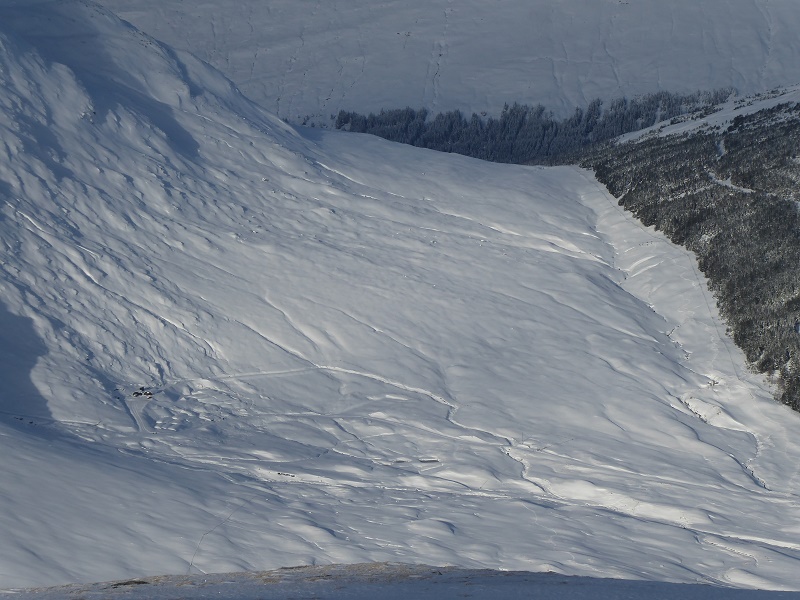
Following my post on what is going on behind the scenes at Scotgold Resources (see here), this post will take a further look at the landscape and wild land impacts of their proposals for storing waste extracted from the mine and their response to the objections made by myself and Mountaineering Scotland (see here). The more “technical” issues, relating to the design and restoration of the proposed tailings stacks, will be picked up in a further post.
Scotgold want to increase the volume of waste that can be left outside the mine
In early posts on the new planning application (see here for example) and in my objection to the Loch Lomond and Trossachs National Park Authority about that application, I expressed concern that Scotgold Resources was wanting to dump far more spoil outwith the mine than the 400,000 tonnes which had been previously agreed. Scotgold’s response in December was in my view less than clear and tried to divert attention to the form of the tailings stacks rather than their volume. Earlier this month, however, they produced a further document comparing the volume of the materials in the original and in the new application (see here). I suspect this was as a result of a request from the responsible Planning Officer, well done them! The document shows that I was right to claim that Scotgold want the LLTNPA to approve plans which would result in far MORE material being dumped outwith the mine than was previously agreed.
The new proposal is to store spoil in ten tailings stacks rather than single large tailings dam which would have required the Allt Eas Anie – of ice climbing fame – to be diverted and a large amount of material from the floor of the glen (the earthfill in the table below ) to be bulldozed to form the dam. Here are the two tables, merged to make comparison easier:
| Original Proposal – | New proposal | |||
| Dam | Stacks | |||
| Tonnage | Volume (m3) | Tonnage | Volume (m3) | |
| earthfill | not specified | 130,273 | n/a | n/a |
| rockfill | not specified | 33,403 | 172,332 | 86,166 |
| filters | not specified | 6,000 | n/a | n/a |
| tailings | 400,000 | 296,296 | 552,779 | 345,487 |
| subtotal | ? | 465,972 | 725,111 | 431,653 |
| Re-circulation pond | ||||
| earthfill | 10,000 | |||
| Plant Bund | ||||
| 27,670 | 19,602 | |||
| Allt Eas Anie Diversion | ||||
| earth | -38,100 | |||
| rock | -6,900 | |||
| Fill (alteration above existing landform) | 503,642 | 451,255 | ||
| Cut (alteration below existing landform) | -45,000 | 0 | ||
If you set aside the earthfill, what the table shows is that Scotgold want to increase greatly the amount of rock (from 33,403 to 86,166m3) and tailings (from 296,296 to 345,487m3) extracted out of the mine. This also has the effect of signficantly increasing the area of ground affected:
“The operational disturbance now relates to 451,255m3, while at restoration this total alteration to landform is 9% larger by volume.”
The point here is that whatever the merits of tailings stacks over a single tailings dam, there would need to be fewer tailings stacks affecting a smaller area of ground (or alternatively the size of the tailings stacks could be reduced) if the LLTNPA retained their original condition that the amount of material that could be left outside the mine could not exceed 400,000 tonnes. Indeed, on Scotgold’s figures in the table above, that would mean 325,000 tonnes of waste being returned to the mine – which would almost halve the number of tailings stacks required! That really would be an improvement on the original proposal!! That is the last thing Scotgold wants, however, which is why they have been less than clear about their proposals up till now.
Part of the reason is cost, its expensive to return waste to mines, although that of course would create far more local jobs, which was one of the main justifications for a gold mine in the National Park in the first place. Also, the creation of a tailings dam requires capital expenditure up front – the dam has to be created first (hence the 130,273m3 of earthfill in the table above) – while the cost of creating the proposed tailings heaps would be spread across the life of the mine.
It appears another reason for the change though is that Scotgold want to be able to extend the mine in future if more gold is discovered:
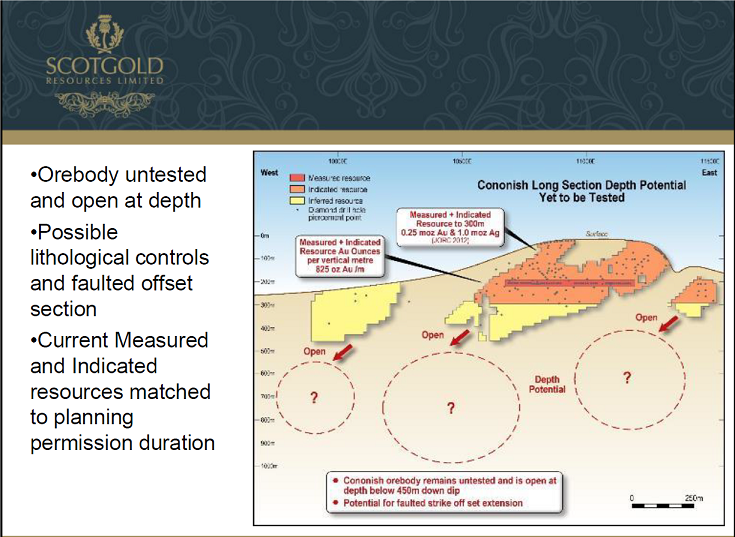
What the schematic plan shows is that potentially there is more gold down there beyond that which has been granted permission to mine at present. Scotgold would be unable to extract this “extra gold” if tailings had to be returned to the mine, as is required at present. It appears therefore that Scotgold wish to be in a position where they could submit a further planning application in future to extend the size of the goldmine – and this in turn could result in even more tailings stacks! The potential cumulative impact of the LLTNPA agreeing to any increase in the amount of tailings stored outside the mine is therefore immense. The LLTNPA and the public need to realise that what is driving the tailings stack proposals is less a concern for the landscape but the financial interests of Scotgold’s main shareholder, Nathaniel Le Roux.
The wider implications beyond Cononish are also significant:
The Cononish mineralisation remains open at depth down plunge and to the west along strike. There is therefore potential to add to the resource by further extensional drilling.
In addition to the currently defined Mineral Resources, Scotgold believes that there is additional resource development potential close to the Cononish mine, subject to appropriate and successful further work. Extensive gold-in-soil anomalies, mineralisation associated with outcrops and trenching and geophysical anomalies close to the current resource clearly warrant further follow up. In addition, there are indications that other reefs are present in the area too. At this stage, such indications are highly conceptual and there is no guarantee that further exploration will define additional Mineral Resources.
So, Scotgold is potentially wanting to develop not just the existing mine at Cononish but further mines close by.
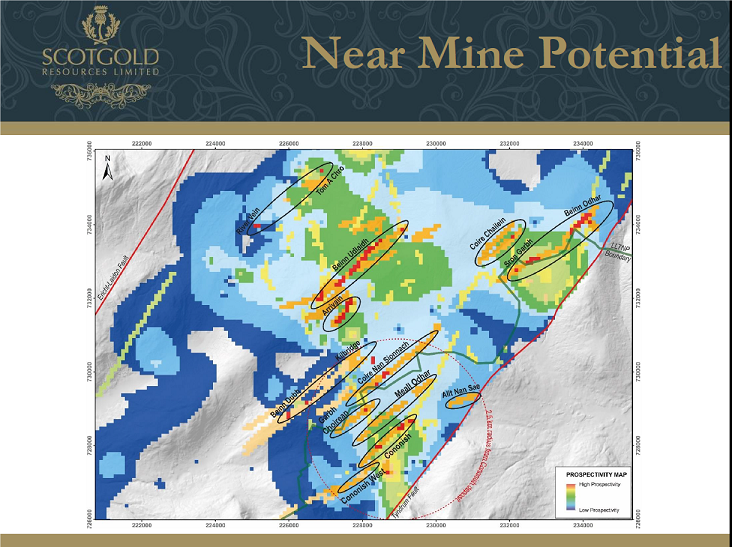
“Based on the resulting prospectivity map, the study identified a series of high priority targets, with 6 targets being located within a 2.5 km radius of Cononish, including 2 targets outside the Loch Lomond and Trossachs National Park (LLTNP). A further 5 targets have been identified within the studied area, all of which are outside the LLTNP. Close to the Cononish deposit, Coire Nan Sionnach and Kilbridge are highlighted as highly prospective, along with two further parallel anomalies between the Cononish deposit and Coire Nan Sionnach.”
So, besides Cononish, Scotgold has identified 4 further “high priority targets” close by within the National Park and five more high priority targets just over the boundary. How many tailings stacks is that going to produce?
The landscape impact of the proposed planning application
“It must however also be noted that while the total volume is of the same order of magnitude, and a slight increase, the current proposal for tailings placement is far superior in relation to the ultimate landform and its landscape fit.”
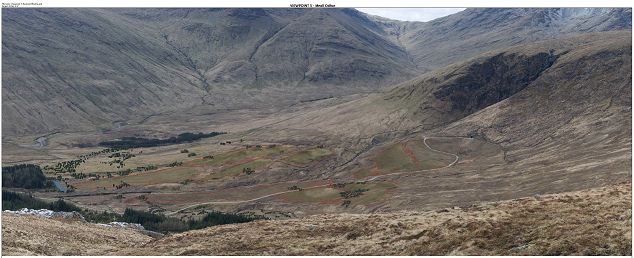
The documents in the Environmental Statement Addendum added to the LLTNPA planning portal in December include further photo montages, requested by the LLTNPA (to their credit), of how the ten tailings heap may look from different angles. Seen from above the size of the heaps is flattened and the photomontage assumes that each heap will fully re-vegetate. There are a number of factors to doubt this, which Bill Stephen will come back to in another piece, but they include the toxic materials in the tailings (think of the all of the bare ground below the Tyndrum Lead mine, bare 170 years later) and the erosive power of rainfall. If bare or even half bare the mounds would look totally different, even from the angle in the photo-montage.
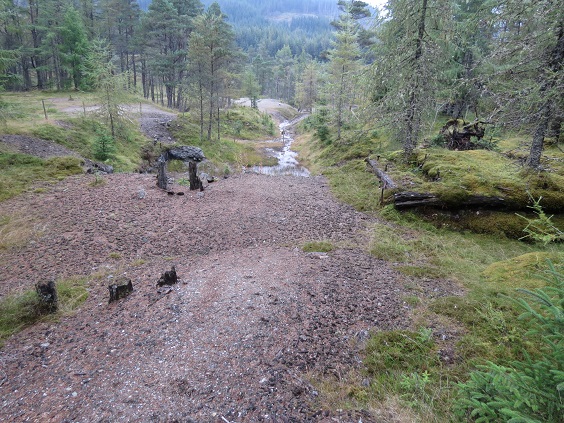
In terms of landscape impact, in my view the LLTNPA should be asking the developers to prepare photomontages of what the area could look like if the plans to create a new moraine field don’t work. It should also be asking for photomontages of what the site will look like from close up (images of what the moraine field will look like from ground level are conspicuously lacking), e.g to a climber approaching the Eas Anie.
Perhaps the LLTNPA has requested this but unfortunately at present they are refusing to publish the report from their Landscape Adviser about the potential landscape impacts of the development and how they could be mitigated. In my view, its in the public interest that the LLTNPA makes such reports publically available at the earliest opportunity as it would enable further debate and comments about the proposals.
Gold mines and the Loch Lomond and Trossachs National Park – a wider perspective
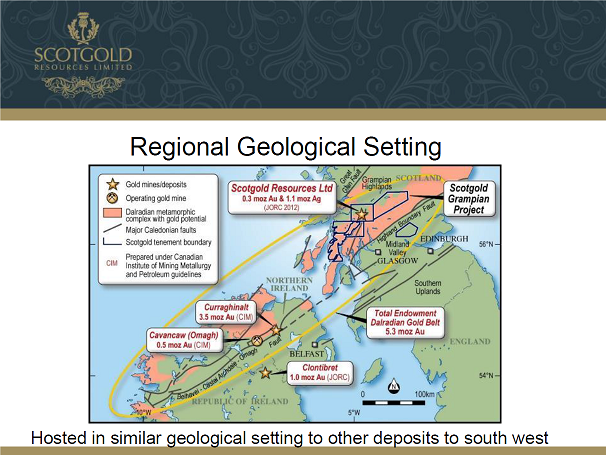
What the Scotgold Map of “Near Mine Potential” demonstrates is what a huge mistake the Loch Lomond National Park Authority made when, under the convenership of the Linda McKay, it reversed its previous opposition to a gold mine within the National Park and consented to Cononish. According to the map and other information on the Scotgold website there are richer gold deposits outwith the National Park which would make far more sense to develop from a commercial perspective (and which incidentally could have met the demands of the local community for jobs). However, because Cononish had been prospected first, that is where the developers first submitted planning applications. If the LLTNPA had drawn the line they should have drawn – mining is incompatible with our National Park’s statutory objectives – the developers would have had to focus on the high priority areas outwith the National Park boundary.
Instead, the LLTNPA potentially faces years of applications and proposals for new developments and waste heaps.
The Crown Estate and the destruction of the landscape
While the Crown Estate has tried to promote a positive image at Tomintoul, most people will not be aware that without its consent, the Cononish gold mine could never have happened. Gold mines, and the exploration for gold, are controlled by the Crown Estate Commissioners who in 2012 granted an unconditional lease to Scotgold for Cononish. Now would be a good time to ask why the Crown Estate was granting licenses and leases for gold mine in National Parks as, in 2016, in the Scotland Act they became accountable to the Scottish Parliament (one of the main recommendations of the Smith Commission). Indeed there is currently a Bill going through Parliament which aims “to:
- reform the duties of the managers of Scottish Crown Estate assets;
- provide legal powers for the transfer and delegation of management of Scottish Crown Estate assets to bodies other than Crown Estate Scotland;
- create a national framework which ensures local communities, local authorities and industries can benefit
The Scottish Crown Estate Bill seeks to achieve these aims by changing the duty managers to manage assets on a purely commercial basis and allowing them to take into account wider social, economic and environmental factors when making management decisions.”
An ideal opportunity for the Scottish Parliament to make it clear that gold mines and other such developments licensed by the crown are NOT compatible with the conservation objectives of National Parks and there should be a presumption against any new such licences or leases in National Parks.
For the record the Scotgold 2017 Annual Report stated it had, in addition to Cononish, made the following Mines Royal Options Agreements with Crown Estates Commissioners:
- Glen Orchy: Location – counties of Perth and Argyll, Scotland UK
- Glen Lyon: Location – counties of Perth and Argyll, Scotland UK
- Inverliever: Location – counties of Dunbarton, Argyll and Perth, Scotland UK
- Knapdale: Location – county of Argyll, Scotland UK
- Ochils: Location – county of Clackmannan, Perth, Kinross and Stirling, Scotland UK
Plenty there to provoke debate in the Scottish Parliament.
What needs to happen
The LLTNPA has a means to prevent the scenario of ever more goldmines being proposed within the National Park and that is to insist that the current planning application is revised so that waste is returned to the mine and the amount stored outside the mine does not exceed the 400,000 tonnes originally agreed. This would have the added benefit of enabling the size and/or number of the proposed tailings stacks to be reduced – which in landscape terms would be an improvement on the application it has already consented.
In doing this, the LLTNPA could make it clear that it has a duty to consider the potential cumulative impacts of further tailings stacks within the National Park and a duty (having conceded that one mine is acceptable) to ensure the landscape impact is as small as possible. It could probably go further and insist that the more profit the mine makes, the more waste should be returned to it (thus creating more jobs and protecting the landscape).
The Scottish Parliament could help strengthen our National Parks by removing the discretion of the Crown Estates Commissioners to grant gold mine and other licenses in protected areas such as National Parks. In my view such decisions should only be taken by the Scottish Parliament and only in the most exceptional circumstances.